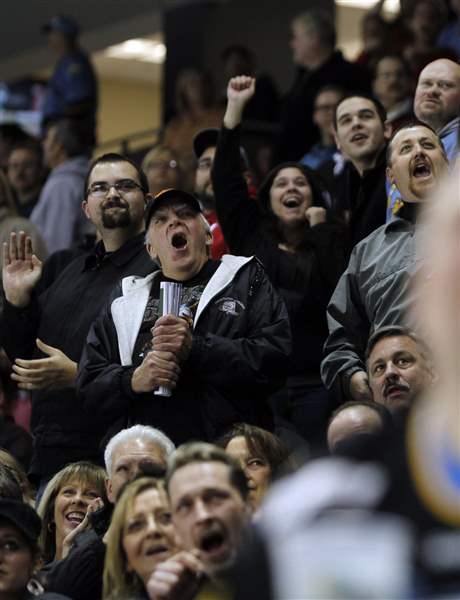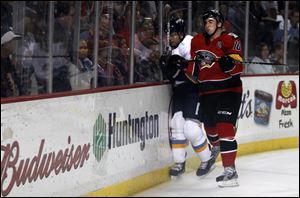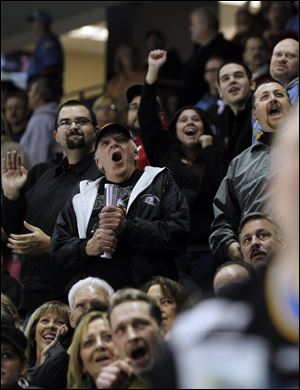
Lockout seems to benefit minor hockey leagues but ECHL, AHL officials want NHL back
12/11/2012
The ECHL’s 24 teams have an aggregate attendance of 1,184,772, a few of them seen here at Huntington Center, through Sunday’s games.
THE BLADE/ZACK CONKLE
Buy This Image

Thanks, in part, to the NHL lockout, attendance is up across the ECHL including Toledo, which is fourth in the league in attendance, drawing an average of 5,751 fans in its first 11 home games,
When it comes to National Hockey League attendance this season, the numbers aren’t difficult to crunch.
Whatever math you decide to do, it all will add up to one number: Zero. Because of a league-wide player lockout, which is now in its 13th week, arenas are empty.
The NHL has cancelled 526 regular-season games to date as a result of the lockout, including the Winter Classic on Jan. 1 between the Toronto Maple Leafs and the Detroit Red Wings, as well as the 2013 NHL All-Star Game.
The Associated Press reported Monday that if players and owners agree to a new collective bargaining agreement, the earliest the 2012-13 season would begin is Dec. 31.
Officials from both the ECHL and the American Hockey League agree on this much — an NHL season, even abbreviated, is vital not only for the health of professional hockey but also for the business aspect of the sport. But both the ECHL and the AHL have seen upticks in attendance of up to 10 percent so far this season.
The ECHL’s 24 teams have an aggregate attendance of 1,184,772 through Sunday’s games, which ECHL commissioner Brian McKenna estimates is about a 10-percent increase from this time last season. McKenna attributes that more to the growth of the league as opposed simply to the fact that the top professional league in North America hasn’t played a game this season.
Three of the ECHL’s four expansion teams are among the top five among team attendance leaders, including Fort Wayne, which leads the ECHL in attendance with an average of 8,002 fans in its first nine home games.
Toledo is fourth in the ECHL attendance, drawing an average of 5,751 fans in its first 11 home games, behind Ontario (6,829) and Orlando (6,265).
Erik Ibsen, the Walleye’s assistant general manager for ticket operations, said in an email that the Walleye’s attendance is up by about 2,000 tickets so far this season, but he cannot attribute the rise directly to the NHL lockout.

The ECHL’s 24 teams have an aggregate attendance of 1,184,772, a few of them seen here at Huntington Center, through Sunday’s games.
“We hope that we’ve reached at certain level of stability with the fan base and the season-ticket-holder bases,” McKenna said. “Typically, attendance will increase in the second half of the season, and that’s been fairly consistent.”
Jason Chaimovitch, the AHL’s vice president of communications, estimates about a 7-percent increase in attendance this season — the AHL has drawn 1,800,641 fans through Sunday’s games, roughly one-third of last season’s total of 6,426,934.
But Chaimovitch cannot estimate how much of that growth is a product of the lockout. He said that Toronto’s AHL franchise has benefited from the Marlies’ run to last spring’s AHL Calder Cup finals, and two AHL games have been played in NHL arenas in Washington, D.C., and Montreal — games that had been scheduled at the Verizon Center and the Bell Centre prior to the start of the NHL lockout.
The Montreal Gazette reported an attendance of 18,582 at Bell Centre for a November AHL game between the Hamilton Bulldogs and the Syracuse Crunch. The Washington Post reported that the Verizon Center, which holds 18,506 for hockey, was at about two-thirds capacity for last week’s AHL game between the Hershey Bears and the Norfolk Admirals.
Geography may also have a role in this season’s small increase in league-wide attendance, as seven ECHL teams are within 65 miles of eight NHL cities, including Toledo; nine AHL teams are within 75 miles of 11 NHL cities.
“In terms of being able to determine if [attendance growth] has to do with the NHL lockout, we have no definitive information,” McKenna said. “I don’t think you’ll see the same impact on attendance in the ECHL as you will in the AHL, because a lot of those markets are very close to an NHL affiliate.”
But AHL and ECHL representatives agree on one thing.
“We need the NHL back,” Chaimovitch said. “They’re the backbone of the business in our sport. In the meantime, though, we’re going to have more attention on us. But the key for us when the NHL comes back is keeping that interest.”
Contact Rachel Lenzi at: rlenzi@theblade.com, 419-724-6510, or on Twitter @RLenziBlade.